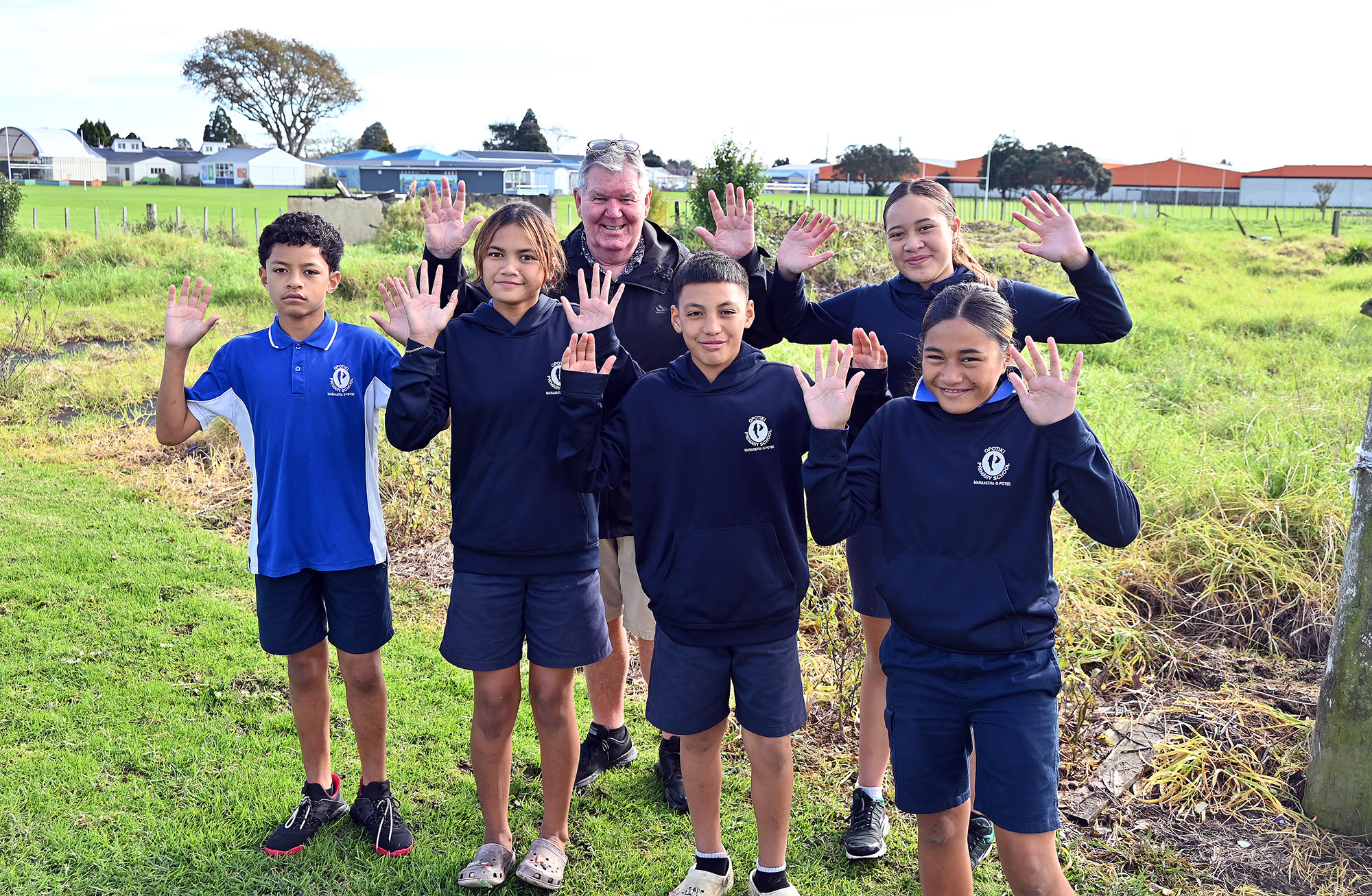The primary school that keeps spreading

MANY HANDS: Principal Tony Howe, with, from left: Ma’ake Nafe, Athena Tawhi, Isaac Kahukiwa, Acya Whakatihi and Syna-Shae Warren (rear). Eventually it is hoped students will plant native trees on the reclaimed school grounds. Photos Paul Charman E5467-02
Paul Charman
Size-wise Ōpōtiki Primary is a whopper, rambling across 3.4 hectares, making it among the largest school of its type in the country.
But soon, when a 2000 square-metre section at the corner of Ford and St John streets is added, the grounds will be even bigger.
Dating from 1873, the school was built on land surveyed as one of the blocks taken during the confiscations of 1865.
Originally it was intended to be a native school, but this designation was changed to “mixed” when Pakeha farmers petitioned to have their children included on the roll.
There’s ample room for the buildings, plus three large playing fields. The grounds easily accommodate a 400-metre track required for the combined primary school athletics events.
The school’s 13.7m pool dating from 1946 is among the oldest of its type in New Zealand. In its heyday, this was used for 800m races, necessitating nearly 60 lengths per race.
But principal Tony Howe has an eye to the future.
Mr Howe likes to do his homework, in this case poring over old museum documents and council records, which show that, by rights, Ōpotiki Primary should really be bigger.
He discovered the now vacant half-acre on the corner of Ford and St John Streets is vested half in the Ministry of Education and half in the Department of Conservation.
The section was previously the site of an historic building, Ōpōtiki’s Old Scout Hall, which was destroyed in a suspicious fire in 2018.
“Most of the building collapsed following the fire and unfortunately some of our children were drawn to the debris, visiting outside of school hours to fossick for bottles and other items,” Mr Howe said.
“It’s been a problem on and off; there were injuries, and the land really needed tidying up.”
So, what was the solution?

“The section is in two titles, one owned by our department (education) and the other by DOC, and both have agreed to us taking charge of the land.
“Waiotahi Contractors are coming in to remove the debris, sow grass and fence the site so that it is incorporated back into the school grounds. We will then look after the mowing and eventually landscape it.
“We didn’t need this land but wanted to resolve a situation nobody was taking responsibility for.
“Of course, if one day either party wants its part of the land back, it will be there for them to take over, but in a lot better state than today.”
Records showed the Old Scout Hall had a colourful history, having been built in 1912-1913 as a structure in which territorial soldiers were to train. During World War II it was a venue for Home Guard training.
“Originally the military used only half the land, but during World War I there was petrol rationing and the home guard had to travel in by horse, so they doubled the size of the section, adding space for a horse paddock,” Mr Howe said.
“We still legally own the horse paddock part and DOC owns the rest.
“The home guard apparently gathered on Sundays and one snippet I read said they had quite a few beers after their drills, so it was a bit of a social gathering venue.”
Records also showed the hall had been used for classes in the 1920s and 30s, as a venue for fairs and by a succession of community groups till the scouts took over late last century.
The scouts and guides eventually moved on, and in 1995 the building was purchased by Ngāti Muriwai Charitable Trust, which wanted it retained for the community.
It became a base for meetings, garage sales, karate, kapa haka, dancing lessons, hangi and fundraising activities. But in later years, with growing maintenance costs, the building was left derelict.
“Like all empty buildings, it was at risk from vandals. In 2018 it was largely destroyed by fire and though the cause was never fully resolved, some children were apparently seen running away after the fire was set,” Mr Howe said.
“It is a shame that we lost one of our historic buildings; quite an impressive and unusual one with a distinctive weatherboard front façade. The main part of the structure was that half-round corrugated iron design you used to see in army camps.
“But at least the site can now be rendered safe and made attractive to passersby – especially when we landscape it, as we plan to do, with native trees.”